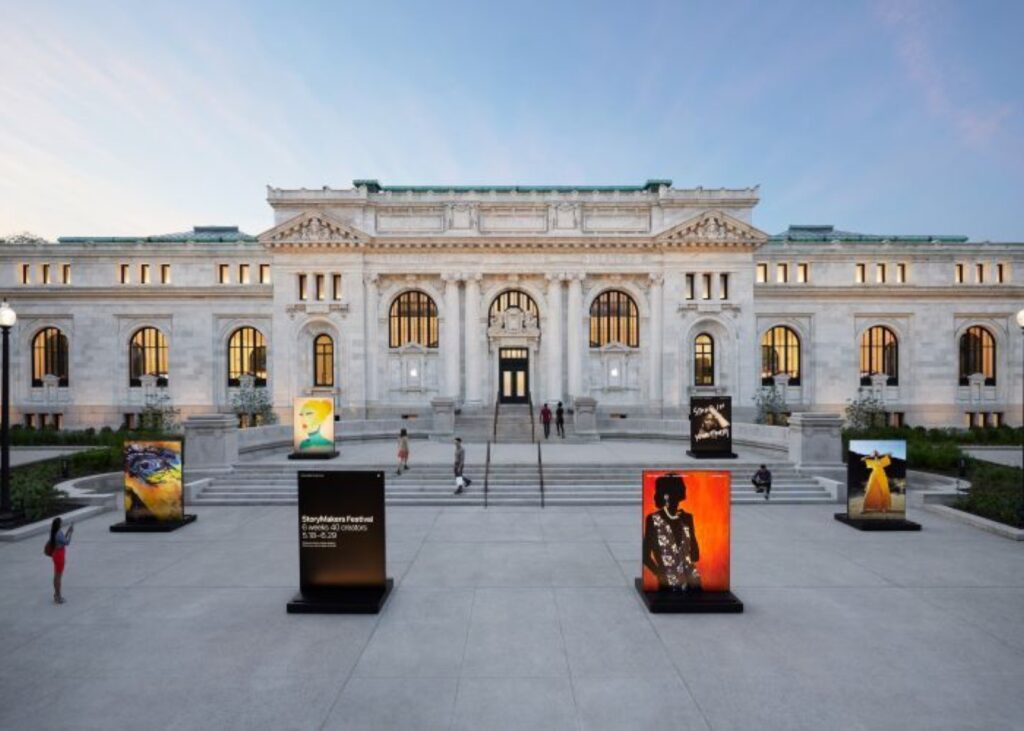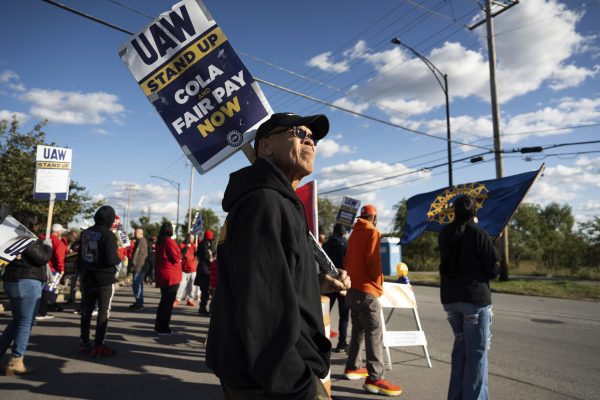Last Saturday morning the iconic Carnegie Library in Washington, D.C., had the vibe of a Big Box store on Black Friday. There was a dramatic countdown as the new Apple store inside prepared to swing open its doors for the first time, and then, at 10 a.m. sharp, as Apple CEO Tim Cook and D.C. Mayor Muriel Bowser stepped out, a crowd of customers streamed in, collecting high-fives and tote bags from the staff pooled around the entrance. The customers took in the grand Beaux-Arts exterior, the high arched ceiling, the vaulting windows, the twin curling staircases, and, of course, the massive wall of iPhones. The staff hooted and hollered. And then the chanting began: “Who are we? Carnegie! Who are we? Carnegie! Carnegie! Carnegie! Carnegie!”
The Apple Carnegie Library betrays the core goal of Carnegie's giving: to create fully public institutions.
The impressive building was constructed with funds from steel magnate Andrew Carnegie in 1903 and served as the Washington Public Library until 1970. Thereafter it hosted various organizations, but in recent years the building has fallen on harder times, and Apple’s opening was the culmination of a painstaking—and expensive—restoration. The library’s marble façade now glows, as do the two Apple logos that flank the entrance like totemic laptops.
But Apple’s approach to the opening suggested that the restoration was not merely architectural. It represented as well the updating of Carnegie’s legacy as civic benefactor. One of the engraved panels on the building’s frieze reads “Dedicated to the Diffusion of Knowledge,” and in their promotion materials, Apple seemed to be inheriting, and updating, this charge. “Inspired by the rich history of Carnegie Library,” one poster announced, “we are imagining Apple Carnegie Library as a brand-new space to learn.” The staff’s chants introduced the space as a twenty-first century benefaction: “We made it, we made it, we made it for y’all.”
It is true that plenty of knowledge will be diffused on the screens sold there. But in two fundamental respects, the Apple Carnegie Library embodies recent developments that betray the principles that animated Carnegie’s giving: the uncritical valorization of philanthro-capitalism and the privatization of public goods and public spaces. Carnegie’s philanthropy was certainly not unimpeachable—it was often warped by his own ego and eccentricity—but we don’t need to idealize it in order to admire elements of it, especially his library campaign. Indeed, reexamining that campaign should help us appreciate the problem with using Carnegie’s philanthropic legacy to promote the opening of an Apple store in the shell of Washington’s old public library.
•••
The Washington Public Library was one of 1,679 library buildings Carnegie and his foundation funded in the United States. They were prime examples of the civic institutions—“ladders upon which the aspiring can rise”—that Carnegie believed the wealthy should bestow upon the nation’s citizens. The earliest libraries he gave were linked to communities to which he had strong ties—Allegheny City (his first home), and then Pittsburgh, Braddock, and Homestead, the sites of his major steel works. (The last town was also the site of a strike that Carnegie’s proxies brutally suppressed, with the help of a Pinkerton private militia.) Eventually Carnegie expanded his library campaign to communities across the nation.
Washington joined the ranks of those communities through a chance encounter. Carnegie met one of the leaders of an effort to establish a public library in the city at a White House function and quickly pledged $250,000 to the cause (his total contributions to the construction would eventually reach $375,000). The availability of Carnegie funds prompted Congress to sign over land, which had previously been used as a public park, on Mount Vernon Square. The library officially opened in January of 1903, with Carnegie and Teddy Roosevelt attending the ceremony. Demand for its services was strong, and it was the first desegregated public facility in the city—a beloved institution for many Washingtonians.
Apple, and the tech industry more generally, has embraced a particular approach to philanthro-capitalism, one in which the products they profit from are presented as powerful forces for good themselves.
Perhaps, even, a little too beloved. Overcrowding was a constant problem, and in 1970, the city’s central library moved to a larger space. Over the next decade the Carnegie building took on a series of tenants, but none managed to set down permanent roots. Squatters occupied the reading rooms, and looters made off with glass from the skylight. In 1980 the University of the District of Columbia moved in, committing more than $4 million to renovations, and used the space for its architecture department and its president’s office; it eventually vacated when its campus shifted locations. In 1999 the Historical Society of Washington, D.C., signed a rent-free ninety-nine-year lease with the city, with plans to open a city history museum in the building. It spent $20 million on renovations and opened in 2003, but then closed a year and a half later. In the following years there were plans for the space to host a music museum, the Spy Museum, and a visitors’ center, but they all fell through, often because of a failure to satisfy the city’s commissions overseeing historic preservation.
Then Apple came calling, with plenty of cash to spend on renovations and an offer to update the space granted there to the DC History Center, which now occupies the upstairs floor, along with an archive devoted to Washington history. The city accepted the deal; in a sense, it is the same one the polity has struck more generally over the last few decades. We have granted the nation’s wealthiest citizens and largest corporations enormous public benefits, privileges, and prestige in exchange for the promise that they would serve the public interest. That, after all, is the win-win logic of philanthro-capitalism, which holds that market forces are the most powerful instruments for achieving social good and that those who have distinguished themselves in harnessing those forces should take the lead as “change agents.”
Carnegie is often considered the cherubic patron saint of philanthro-capitalism. In his famous 1889 essay, “The Gospel of Wealth,” which has been passed around the nation’s philanthropic elite like an early nineteenth-century missionary tract, Carnegie urged Gilded Age industrialists to apply the accumulative and entrepreneurial talents that had generated massive personal fortunes toward philanthropic ends. The man of wealth, Carnegie wrote, must consider himself “a mere trustee and agent for his poorer brethren, bringing to their service his superior wisdom, experience, and ability to administer.”
Yet Apple, and the tech industry more generally, has embraced a particular approach to philanthro-capitalism, one in which the products and services they profit from are presented as powerful forces for good themselves—today’s tech products forge social networks and connections, offer ladders for the aspiring to rise, and, yes, diffuse knowledge. Apple co-founder Steve Jobs took this stance to an extreme. When called out for his notable lack of public commitment to philanthropy, he explained that he believed it more important to devote his energies and talents to building his company. (When Jobs made his triumphant return back to Apple in 1997, he shuttered the company’s existing philanthropic programs.) This philanthropic disavowal became incorporated into Jobs’ mythic aura. One defender labeled Jobs “the world’s greatest philanthropist” in the Harvard Business Review precisely because he didn’t waste time researching and writing checks to charities, allowing himself to be single-mindedly devoted to developing the iPad, the iPhone, Pixar, and various other enterprises that transformed the world for the better.
“The amassing of wealth is one of the worst species of idolatry,” Carnegie told himself.
There are elements of Carnegie’s attitude toward philanthropy that suggest a rebuke of this form of contemporary philanthro-capitalism. From nearly the moment he had enough money to consider philanthropy as a vocation, Carnegie understood the accumulation of private wealth and its charitable redistribution as distinct endeavors, each governed by their own moral imperatives. As a thirty-three-year old, Carnegie penned a private note to himself vowing that he would resign from business within a few years in order to devote himself to self-improvement and his wealth to “benevolent purposes.” “The amassing of wealth is one of the worst species of idolatry,” he reminded himself.
Although he frequently considered retirement, Carnegie didn’t heed his own admonition; and it was the “Gospel of Wealth,” written two decades later, that provided him a way out. Once a capitalist committed himself to philanthropy, “the struggle for more is completely freed from selfish or ambitious taint and becomes a noble pursuit,” he wrote. “The more he makes, the more the public gets.” And yet he never discarded the belief that the accumulative logic that directed his steel mills and the moral logic that guided his giving were different. (As historian Jon Levy has explained, this line of demarcation was essential for the forging of distinct for-profit and nonprofit sectors.) As Carnegie’s reputation as a ruthless capitalist hardened, cemented by his commitment to union-breaking and to installing the twelve-hour day at his mills, he had an interest in honoring that divide and in forging a separate identity as a philanthropist. When residents of Pittsburgh protested a library, music hall, and art gallery that Carnegie had donated to the city, citing his wealth’s “taint,” he urged them to disentangle their judgment of him from their assessment of his philanthropic offerings. Workmen, he insisted, “must separate the donor and his many faults from libraries and music halls and art galleries, which have none.”
Clearly, this partition between how money was made and how it was given away could be exploited, serving as a way to insulate the former from moral judgment. But there was another relationship between the two realms, one the younger Carnegie, at least, appreciated: an elevated domain of philanthropic pursuits and “benevolent purposes” could provide the grounds from which the world of capitalist accumulation was critiqued. Dissolving the philanthropic imperative into a bath of the commercial—the type of alchemy at work in the Apple Carnegie Library—robs the former of its potential to chasten and discipline capitalism, a power that is now being explored by an emerging corps of philanthropic leaders, evangelizing for a New Gospel of Wealth.
•••
Yet another element of Carnegie’s philanthropy clashes with recent developments represented by the Apple Carnegie Library. Fundamental to Carnegie’s library campaign was the idea that they be fully public institutions—that is, democratically supported and tax-funded. In order for a town to receive funding to construct a Carnegie library, it needed to provide the site of the building, as well as an annual appropriation of 10 percent of the construction costs, in order to cover maintenance and upkeep, staff salaries, and books. As the largest single-building contribution Carnegie made outside the Pittsburgh area, the Washington Public Library roughly fit this framework. Carnegie conditioned his initial gift of $250,000 on Congress providing the site and maintenance funds of no less than $10,000 a year.
No amount of rhetorical silting can hide the erosion of public space that has taken place on Mount Vernon Square.
Carnegie considered the expansion of civic responsibility that his giving stoked just as significant a contribution as bricks, mortar, and marble. As he once remarked, “I do not wish to be remembered for what I have given, but for that which I have persuaded others to give.” Like several other major philanthropists of the early twentieth century—John D. Rockefeller and Julius Rosenwald in particular—Carnegie feared that the public might develop an excessive reliance on benefactors. The philanthropist’s highest aim was thus not to supplant the public’s responsibility to meet civic needs but to nurture it, either through demonstration projects or matching and challenge gifts.
That task at times required the philanthropist to absent himself from the details of his own donation. In Carnegie’s case, as the debate raged over the site where the Washington library would be constructed, factions representing the two leading contenders asked Carnegie to step in. He responded with a curt letter published in a Washington newspaper: “I have nothing whatever to do with the site. This is not my affair.” It is difficult to imagine hearing that phrase from contemporary philanthro-capitalists.
On some level, then, the Carnegie-inspired philanthropist worked toward his own obsolescence: eventually he could step aside and allow citizens to carry the financial and civic burden on their own. This idea carried an implicit self-critique—an acknowledgement of the limits of philanthropy within a democracy, a willingness to subordinate the status of the private benefactor to the tax-paying citizen. As Carnegie announced at the dedication ceremony for the Washington library, “This is not charity, this is not philanthropy. . . . It is the people helping themselves by taxing themselves.”
While we should not ignore the legitimate concerns raised when private funds are used to finance the state—a trend sometimes referred to as “patriotic philanthropy”—we should recognize that there are elements within that type of giving that can claim stronger ties of affinity to Carnegie’s philanthropic approach than whatever business is now going on in the D.C. building that bears his name. Where Carnegie’s library campaign sought to apply private wealth to the expansion of public spaces and public goods, the Apple Carnegie Library represents a countervailing force: thoroughgoing privatization.
Apple appears to appreciate the awkwardness of this trajectory. The Apple Carnegie Library is one of thirteen that the company has recently opened and introduced as “town squares,” shifting attention from the stores’ commercial purposes to their civic ones. Sure, you will be able to buy iPhones there, but the stores will also offer workshops and classes where customers can hone their coding or photo-editing skills. As CEO Tim Cook recently told the Washington Post, “We’ve been serving the creative community as a company since the founding of the company, and the truth is everyone should be a part of the creative community, so this is our way to democratize it.” Everyone will be welcome, Apple has insisted, even those not seeking a product upgrade. Indeed, at the store’s opening, staff chanted “For the People! For the People!” which echoed the inscription on a curved granite bench in the front terrace that once described the library as “A University for the People.”
The “town square” label is an impressive branding effort, but no amount of rhetorical silting can hide the erosion of public space that has taken place on Mount Vernon Square. The Carnegie Library Apple store—let us call it that—is fundamentally a commercial venue, run by a corporation accountable to its shareholders. And it arrives on the scene when actual public libraries are both starved for resources and dramatically expanding their own civic functions, offering, as sociologist Eric Klinenberg has recently reminded us, “companionship for older adults, de facto child care for busy parents, language instruction for immigrants and welcoming public spaces for the poor, the homeless and young people.”
Perhaps the most important civic service the Carnegie Library Apple store can now offer, then, is to remind us of the preciousness and precariousness of truly public spaces. The gap between what the Carnegie Washington library once was and now is should dismay us—giving us a sense of loss that can serve as a ladder for our democratic aspirations to rise.








